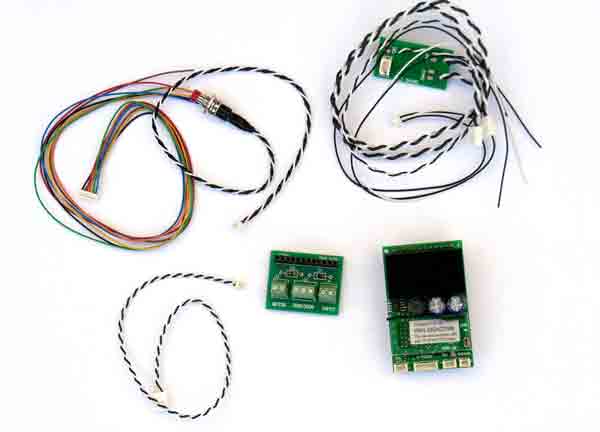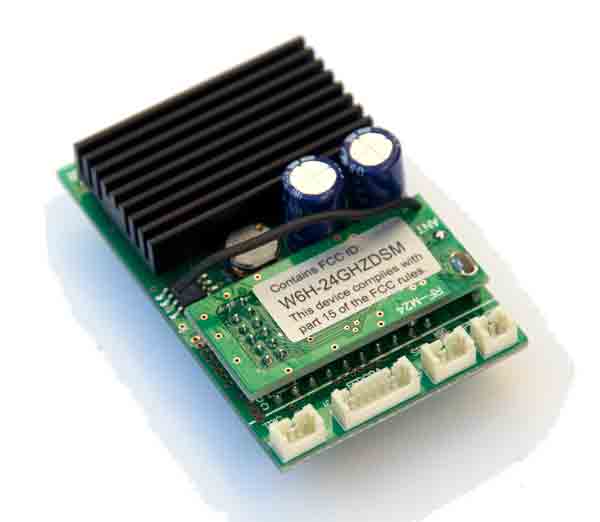Aristo-Craft Trains
698 S. 21st St.
Irvington NJ 07111
Price: $175
Website: www.aristocraft.com
Wireless throttle/sound system combination with generic diesel sound for Aristo-Craft’s Revolution control system
Pros: Self-contained wireless receiver/throttle/sound all on one board; sound component can be turned off and receiver used with third-party sound systems
Cons: Sockets for speaker and other plugs may come off of board when you try to disconnect them; volume resets to maximum after power is interrupted
That’s where Aristo-Craft’s new sound Revolution receiver fits in. This new receiver is a replacement for their previous Revolution receiver, and it comes with built-in sound. Before I go any further, let me say that you can permanently turn the sound off—just don’t plug the speaker into the board. Without the speaker plugged in, the board operates identically to the older, non-sound Revolution receivers.
The Revolution system was reviewed in the August 2009 GR. There are subtle differences between the two boards that I’ll address later but, in terms of the core operation of the motor control of the board, I refer you to that review. For the sound feature, you need to use the Revolution system; there’s no provision for analog DC operation, nor is it compatible with other third-party control systems.
Aristo-Craft describes the premise behind this sound system as “simple.” They wanted something that was automatic and didn’t need any special wiring, programming, or anything. They were aiming at something a modeler could plug into a locomotive and be off and running with sound, but be able to turn it off just as easily, if desired. With that in mind, let’s take a look at what you get.
Aristo-Craft introduced this new sound receiver with a generic diesel-locomotive sound. Plans call for additional sounds to be added to the line-up over time, both steam and diesel, with the eventual ability to download sounds from the Internet. But, for now, it’s a diesel.
The receiver/throttle/sound system is all on one board, designed to plug into the sockets common to both Aristo-Craft and Bachmann locomotives. It comes with a small adapter board so you can install it in other non-socket-equipped locomotives. This board is fitted with screw terminals to connect the wires—a welcome improvement over the old version. It also includes a plug with six accessory leads to trigger other functions, like lights, smoke, and sounds (if you’re using a third-party sound board instead of the on-board sounds). Also included are a pushbutton for linking the receiver with the transmitter, and a light/smoke control board for controlling high-current accessories like incandescent lights and smoke units.
When you first plug the board in and turn it on, you must link it to your transmitter. Go to the “linking” setting on the transmitter menu, press “enter,” then press and release the link button attached to the receiver. An LED on the board will flash and the transmitter will display “Linking Passed” if all goes well. Once it’s linked and you back out of the menu to the main screen, you’ll hear the diesel sound kick in. If you don’t want to listen to it, hit the “1” key, and it shuts off. (Note: Function 1 must be set to “latching” or you only hear the sound when the button is pressed.) The “2” button will ring the bell and the “3” button blows the horn. The bell will ring for eight rings, then shut off. If you want it to ring longer, keep hitting the “2” button. The horn blows a pre-set pattern every time you hit the “3” key. That’s pretty much it in terms of how you can control sounds.
Sound volume (high-medium-low) is controlled by the “7-8-9” keys on the keypad, respectively. In the confines of my workshop, even “low” is pretty loud but, outdoors and in noisy environments like train shows, the volume levels are acceptable. The “4-5-6” function keys are available to trigger lights and smoke via the accessory harness, regardless of whether you’re using the on-board sound or not.
Regarding automatic sounds, when the throttle’s stopped, the sound plays at a low volume with the motor at a low idle. This plays for a minute or so, then it times out and stops. It will start again when you increase the throttle. As soon as you do increase the throttle, the volume jumps a bit and the motor sound increases in pitch as you increase the throttle. A brake-release sound goes off when you start to increase the throttle and, at about speed step 20, the whistle blows twice and the bell rings eight times. Above that, the only changes are that the motor sound continues to increase in pitch until the throttle reaches full speed. When you decrease the throttle, the pitch of the motor decreases with the speed and you get some brake squeal as the locomotive comes to a stop.
When I had the system running in my backyard, the sound quality was every bit as pleasing to my ears as other basic sound systems I’ve heard over the years. Nothing about it got tedious or annoying or had me looking for the “1” key to turn it off, which can’t be said for some of the simple systems I remember from years ago. Are your neighbors going to think the Union Pacific just built a mainline through their backyard? Probably not.
As mentioned, there are minor differences between this and the old non-sound receiver. First and foremost, there’s no longer an on-board “link” button. Aristo-Craft supplies a pushbutton on a short tether that gets plugged into the board to link things together.
It’s advisable to mount this button in an inconspicuous place so you can re-link your receiver to the transmitter should the need arise. If you can gain easy access to the electronics, you may be able to get away with just plugging it into the board when necessary.
There’s no longer a means to plug in a capacitor board to compensate for dirty track, for those using this system on track power. Aristo-Craft tells me they revamped the circuitry and were able to fit two small capacitors that are adequate for that function. In my tests, I didn’t notice any issues with power dropping out over dirty track. Your mileage (like your track) may likely vary. I did notice, on the odd occasion when the system lost power and regained it, the sound volume reset to the loud setting. That was the only strange behavior I found running on track power. If you’re running on battery power (or just powering up on track power), know that the volume will be set to maximum when you first hear it.
You’ll want to be careful with the plug-in sockets along the edge of the board. Putting the plugs in is easy. When/if you take them out, hold the socket in place with your fingernail while pulling out the plug. The plastic part of the socket is not secured to the PC board and may pull out, leaving just the pins sticking up. A small drop of Super Glue might keep things in place.
Overall, this board lives up to its promise. It’s a “one-stop shop” for power, control, and sound. I took the receiver out of the box, plugged it into the appropriate socket in the locomotive, set it on the track, and was off and running with sound and command control. Taking the extra 30 seconds to plug in the battery, I was again off and running with sound, command control, and no track power. That’s precisely what this board is designed to do—make everything easy for the user. To that end, it does it well.
If you’re the type of operator who just wants basic, no-frills sounds as a background to your railroad, I don’t think you’ll be disappointed. And if you don’t want their on-board sound, “off” is just a keystroke away.















